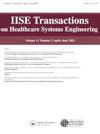了解慢性病患者的护理过渡通知
IF 1.5
Q3 HEALTH CARE SCIENCES & SERVICES
IISE Transactions on Healthcare Systems Engineering
Pub Date : 2021-04-06
DOI:10.1080/24725579.2021.1912217
引用次数: 1
摘要
摘要慢性病患者如果护理过渡协调不力,可能面临再次住院甚至死亡的风险。护理过渡给护理协调带来了挑战,例如不同护理环境之间的信息交流不足或效率低下,即沟通。本文重点关注慢性病患者,特别是心力衰竭(HF)和慢性阻塞性肺病(COPD)患者在护理过渡期间发生的沟通。使用60次采访参与护理过渡的医疗保健专业人员(护理经理、护士、医生、社会工作者、行政助理)的数据,我们确定了总共93次沟通事件,在这些事件中,医疗保健专业人士相互通知了四种类型的患者过渡:入院、出院、,院内转诊和急诊科(ED)就诊。结果显示,医疗保健专业人员使用各种媒体(最常见的是电话、CM软件、面对面)相互通知患者过渡情况并交流其他信息。通信媒介的选择取决于媒介对发送者和接收者的可用性、消息的目的和紧迫性。例如,护理管理软件用于简单地相互通知患者过渡,而电话用于提供关于患者的额外重要、时间敏感的信息。我们相信,具有适当功能(同步、异步、状态指示器、自动生成通知)的中央卫生IT可以提高护理过渡期间的沟通效率,并可能有助于减少慢性病患者的再次住院或死亡。本文章由计算机程序翻译,如有差异,请以英文原文为准。
Understanding care transition notifications for chronically ill patients
Abstract Chronically ill patients may be at risk of re-hospitalization or even death if their care transitions are poorly coordinated. Transitions of care create challenges for care coordination, such as insufficient or inefficient information exchange, i.e. communication, between different care settings. This paper focuses on communication that occurs during transitions of care for chronically ill patients, specifically those with heart failure (HF) and chronic obstructive pulmonary disease (COPD). Using data from 60 interviews with healthcare professionals (care managers, nurses, physicians, social workers, administrative assistants) involved in care transitions, we identified a total of 93 communication events in which healthcare professionals notified each other about four types of patient transitions: hospital admission, hospital discharge, intra-hospital transfer and emergency department (ED) visit. Results show that healthcare professionals use a variety of media (most frequently telephone, CM software, face-to-face) to notify one another about patient transition and communicate additional information. The choice of communication medium depends on the availability of the medium to the sender and the receiver, the purpose and urgency of the message. For example, care management software is used to simply notify one another about patient transition, while telephone is used to provide additional important, time-sensitive information about the patient. We believe a central health IT with appropriate capabilities (synchronous, asynchronous, status indicator, auto-generated notifications) can make communication during care transition more efficient and potentially help reduce re-hospitalization or death among chronically ill patients.
求助全文
通过发布文献求助,成功后即可免费获取论文全文。
去求助
来源期刊

IISE Transactions on Healthcare Systems Engineering
Social Sciences-Safety Research
CiteScore
3.10
自引率
0.00%
发文量
19
期刊介绍:
IISE Transactions on Healthcare Systems Engineering aims to foster the healthcare systems community by publishing high quality papers that have a strong methodological focus and direct applicability to healthcare systems. Published quarterly, the journal supports research that explores: · Healthcare Operations Management · Medical Decision Making · Socio-Technical Systems Analysis related to healthcare · Quality Engineering · Healthcare Informatics · Healthcare Policy We are looking forward to accepting submissions that document the development and use of industrial and systems engineering tools and techniques including: · Healthcare operations research · Healthcare statistics · Healthcare information systems · Healthcare work measurement · Human factors/ergonomics applied to healthcare systems Research that explores the integration of these tools and techniques with those from other engineering and medical disciplines are also featured. We encourage the submission of clinical notes, or practice notes, to show the impact of contributions that will be published. We also encourage authors to collect an impact statement from their clinical partners to show the impact of research in the clinical practices.
 求助内容:
求助内容: 应助结果提醒方式:
应助结果提醒方式:


